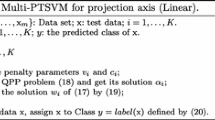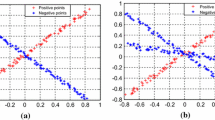Abstract
Multiple recursive projection twin support vector machine (MPTSVM) is a recently proposed classifier and has been proved to be outstanding in pattern recognition. However, MPTSVM is computationally expensive since it involves solving a series of quadratic programming problems. To relieve the training burden, in this paper, we propose a novel multiple least squares recursive projection twin support vector machine (MLSPTSVM) based on least squares recursive projection twin support vector machine (LSPTSVM) for multi-class classification problem. For a \(K(K>2)\) classes classification problem, MLSPTSVM aims at seeking K groups of projection axes, one for each class that separates it from all the other. Due to solving a series of linear equations, our algorithm tends to relatively simple and fast. Moreover, a recursive procure is introduced to generate multiple orthogonal projection axes for each class to enhance its performance. Experimental results on several synthetic and UCI datasets, as well as on relatively large datasets demonstrate that our MLSPTSVM has comparable classification accuracy while takes significantly less computing time compared with MPTSVM, and also obtains better performance than several other SVM related methods being used for multi-class classification problem.







Similar content being viewed by others
References
Cortes C, Vapnik V (1995) Support vector networks. Mach Learn 20(3):273–297
Burges C (1998) A tutorial on support vector machines for pattern recognition. Data Min Knowl Discov 2:121–167
Noble W (2004) Support vector machine applications in computational biology. In: Schöelkopf B, Tsuda K, Vert J-P (eds) Kernel methods in computational biology. MIT Press, Cambridge, pp 71–92
Li Y, Shao Y, Jing L, Deng N (2011) An efficient support vector machine approach for identifying protein s-nitrosylation sites. Protein Pept Lett 18(6):573–587
Li Y, Shao Y, Deng N (2011) Improved prediction of palmitoylation sites using PWMs and SVM. Protein Pept Lett 18(2):186–193(8)
Vapnik V (1998) Statistical learning theory. Wiley, New York
Suykens J, Vandewalle J (1999) Least squares support vector machine classifiers. Neural Process Lett 9(3):293–300
Fung G, Mangasarian O (2005) Multicategory proximal support vector machine classifiers. Mach Learn 59:77–97
Mangasarian O, Wild E (2006) Multisurface proximal support vector classification via generalize eigenvalues. IEEE Trans Pattern Anal Mach Intell 28(1):69–74
Jayadeva R, Khemchandani R, Chandra S (2007) Twin support vector machines for pattern classification. IEEE Trans Pattern Anal Mach Intell 29(5):905–910
Qi Z, Tian Y, Shi Y (2015) Successive overrelaxation for laplacian support vector machine. IEEE Trans Neural Netw Learn Syst 26(4):674–683
Tanveer M (2015) Robust and sparse linear programming twin support vector machines. Cogn Comput 7(1):137–149
Shao Y, Deng N, Chen W, Wang Z (2013) Improved generalized eigenvalue proximal support vector machine. IEEE Signal Process Lett 20(3):213–216
Kumar M, Gopal M (2009) Least squares twin support vector machines for pattern classification. Expert Syst Appl 36(4):7535–7543
Shao Y, Zhang C, Wang X, Deng N (2011) Improvements on twin support vector machines. IEEE Trans Neural Netw 22(6):962–968
Shao Y, Deng N (2012) A coordinate descent margin based-twin support vector machine for classification. Neural Netw 25:114–121
Qi Z, Tian Y, Shi Y (2012) Laplacian twin support vector machine for semi-supervised classification. Neural Netw 35:46–53
Shao Y, Chen W, Deng NY (2014) Nonparallel hyperplane support vector machine for binary classification problems. Inf Sci 263(1):22–35
Tian Y, Qi Z, Ju X (2014) Nonparallel support vector machine for pattern classification. IEEE Trans Cybern 44(7):1067–1079
Wang Z, Shao Y, Bai L, Deng N (2014) Twin support vector machine for clustering. IEEE Trans Neural Netw Learn Syst. doi:10.1109/TNNLS.2014.2379930
Ye Q, Zhao C, Ye N, Chen Y (2010) Multi-weight vector projection support vector machines. Pattern Recognit Lett 31(13):2006–2011
Chen X, Yang J, Ye Q, Liang J (2011) Recursive projection twin support vector machine via within-class variance minimization. Pattern Recognit 44(10):2643–2655
Shao Y, Wang Z, Chen W, Deng N (2013) A regularization for the projection twin support vector machine. Knowl-Based Syst 37:203–210
Shao Y, Deng N, Yang Z (2012) Least squares recursive projection twin support vector machine for classification. Pattern Recognit 45(6):2299–2307
Weston J, Watkins C (1998) Multi-class support vector machines. Technical report CSD-TR-98-04
Schwenker F (2000) Hierarchical support vector machines for multi-class pattern recognition. In: Fourth international conference on knowledge-based intelligent information engineering systems & allied technologies, vol 2, pp 561–565
Lee Y, Lin Y, Wahba G (2004) Multicategory support vector machines: theory and application to the classification of microarray data and satellite radiance data. J Am Stat Assoc 99(465):67–81
Yang Z, Shao Y, Zhang X (2013) Multiple birth support vector machine for multi-class classification. Neural Comput Appl 22(1Suppl):153–161
Li C, Huang Y, Wu H, Shao Y, Yang Z (2014) Multiple recursive projection twin support vector machine for multi-class classification. Int J Mach Learn Cybern. doi:10.1007/s13042-014-0289-2
Golub G, Van Loan C (1996) Matrix computations, 3rd edn. Johns Hopkins University Press, Baltimore
Belhumeur P, Hespanha J, Kriegman D (1997) Eigenfaces vs. fisherfaces: recognition using class specific linear projection. IEEE Trans Pattern Anal Mach Intell 19(7):711–720
Yang J (2003) Why can LDA be performed in PCA transformed space? Pattern Recognit 36(2):563–566
Bishop C (2006) Pattern recognition and machine learning. Springer, New York
Tao Q, Chu D, Wang J (2008) Recursive support vector machines for dimensionality reduction. IEEE Trans Neural Netw 19(1):189–193
Lee YJ, Mangasarian O (2001) RSVM: reduced support vector machines. Technical report 00-07. Data Mining Institute, Computer Sciences Department, University of Wisconsin, Madison (2001)
Blake C, Merz C (1998) UCI repository for machine learning databases. http://www.ics.uci.edu/mlearn/MLRepository.html
Chang C, Lin C (2011) LIBSVM: a library for support vector machines. http://www.csie.ntu.edu.tw/cjlin/libsvmtools/datasets
Chang C, Lin C (2011) LIBSVM : a library for support vector machines. ACM Trans Intell Syst Technol 2(27):1–27
Duda R, Hart P, Stork D (2012) Pattern classification, 2nd edn. Wiley, New York
Jin Z, Yang J, Hu Z, Lou Z (2001) Face recognition based on the uncorrelated discriminant transformation. Pattern Recognit 34:1405–1416
Acknowledgments
The authors would like to thank the editors and reviewers for their valuable comments and helpful suggestions, which improved the quality of this paper. This work is supported by the National Natural Science Foundation of China (Nos. 11201426, 11371365, 11426202 and 11426200), the Zhejiang Provincial Natural Science Foundation of China (Nos. LQ12A01020, LQ13F030010, LY15F030013, and LQ14G010004), the Ministry of Education, Humanities and Social Sciences Research Project of China (No. 13YJC910011) and the Science Foundation of Chongqing Municipal Commission of Science and Technology (Grant No. CSTC201 4jcyjA40011) and Scientific and Technological Research Program of Chongqing Municipal Education Commission (Grant No. KJ1400513).
Author information
Authors and Affiliations
Corresponding author
Rights and permissions
About this article
Cite this article
Yang, ZM., Wu, HJ., Li, CN. et al. Least squares recursive projection twin support vector machine for multi-class classification. Int. J. Mach. Learn. & Cyber. 7, 411–426 (2016). https://doi.org/10.1007/s13042-015-0394-x
Received:
Accepted:
Published:
Issue Date:
DOI: https://doi.org/10.1007/s13042-015-0394-x




